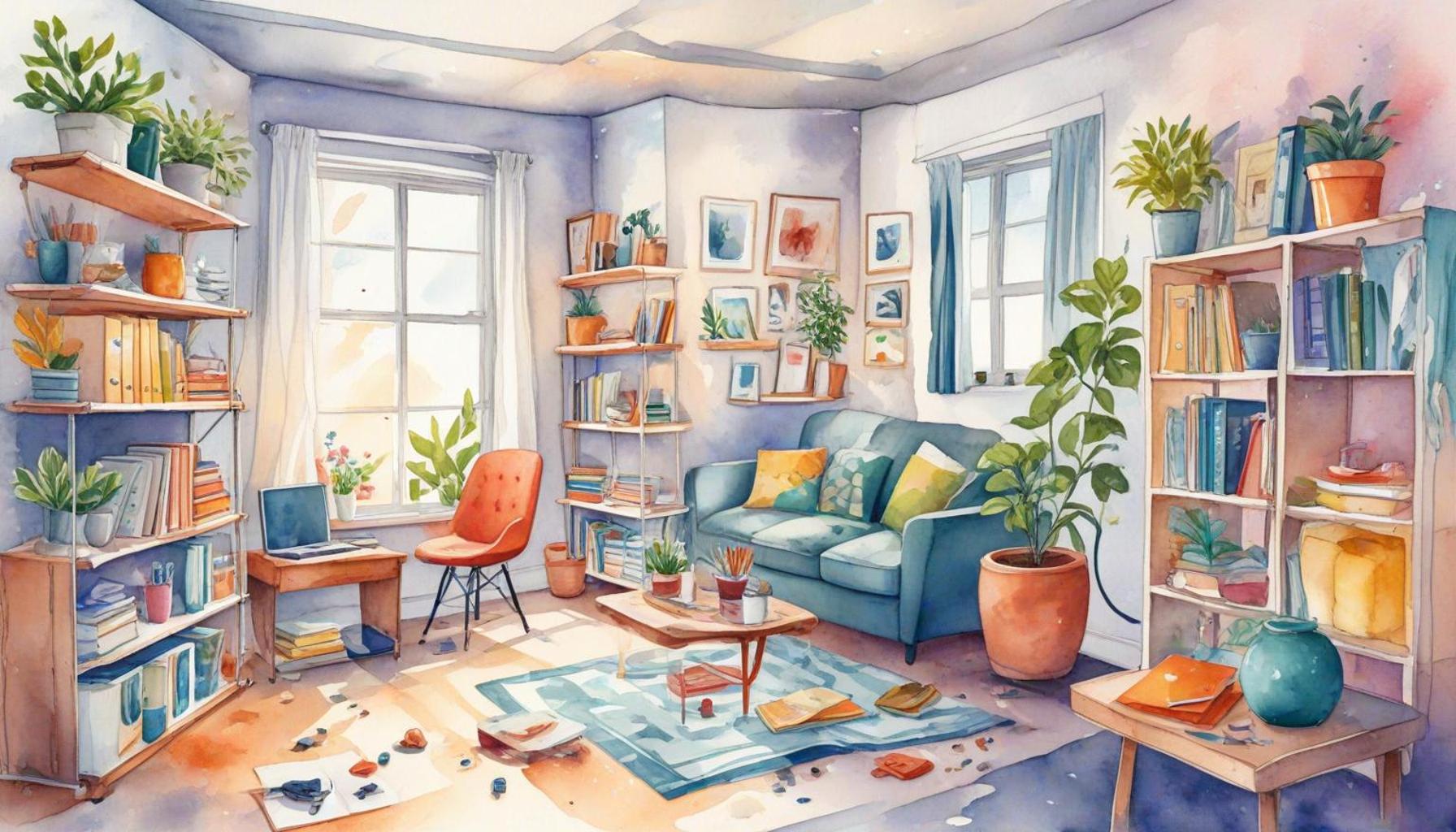The Art of Letting Go: Effective Techniques to Reduce Clutter at Home

Understanding the Impact of Clutter
The presence of clutter can often feel like a weight on our shoulders, subtly influencing our emotional state and daily functioning. Studies indicate that cluttered environments can lead to heightened stress levels, reducing our ability to think clearly and make decisions effectively. Consequently, tackling clutter goes beyond mere aesthetics; it plays a vital role in enhancing our overall quality of life.
Why Declutter? The Benefits Explained
Recognizing the positive outcomes of decluttering can make the process more appealing. Here are some compelling reasons:
- Improves Mental Clarity: A decluttered space promotes a sense of organization, allowing individuals to think more clearly. For example, many creative professionals find that their best ideas emerge in tidy environments, where distractions are minimized.
- Enhances Well-being: Research shows a direct link between a clean space and reduced anxiety levels. This can be particularly important for people with mental health challenges; a tidy home can foster a greater sense of tranquility. A study conducted by the UCLA found that women in cluttered homes experienced higher levels of stress compared to their neatly organized counterparts.
- Increases Productivity: Households that embrace minimalism often notice an uptick in productivity. The easier it is to navigate through your living space, the more time and energy you can devote to essential tasks. For instance, a well-organized kitchen makes cooking and meal prep a much smoother process.
Exploring Effective Decluttering Techniques
If you’re ready to reclaim your space, several effective methods can help guide you through the decluttering process:
- The 30-Day Rule: This approach suggests that if you haven’t used an item in the last month, it may be time to say goodbye. For example, if you have not worn a particular piece of clothing in 30 days, it’s likely it won’t be missed.
- One In, One Out: This technique encourages mindful consumption by ensuring that for every new item acquired, an old one must be removed. This simple rule can prevent clutter from rebuilding in your home.
- Sentimental Items Approach: Sentimental items can often take up the most space. It is crucial to evaluate which keepsakes truly hold sentimental value and bring joy. By doing this, you might consider keeping a few cherished items, rather than boxes filled with memories that may not occupy a significant place in your heart.
Implementing these techniques isn’t just about physical space; it’s also about cultivating a mindset that values simplicity and intentional living. Letting go can be challenging, but with determination and the right strategies, you can create an environment that fosters peace, productivity, and joy. As you continue to navigate your decluttering journey, remember that a clearer space leads to a clearer mind, and the positive impacts of your efforts will extend far beyond your living room.
DISCOVER MORE: Click here to enhance your productivity

Transformative Mindset Shifts for Effective Decluttering
Before diving into practical techniques, it’s essential to address the underlying mindset that can greatly influence the decluttering process. The concept of letting go often challenges not only our physical space but also our emotional attachments. By fostering a transformative mindset, you can approach clutter with a new perspective and discover the true liberating power of decluttering.
Assessing Your Relationship with Clutter
Understanding why we hold onto items can help illuminate your personal decluttering journey. Often, we cling to possessions due to past experiences, feelings of nostalgia, or even a fear of future regret. Initiating a conversation with yourself about these underlying feelings might lead to valuable insights. Ask yourself:
- What emotions are tied to this item? Recognizing the emotional weight of your belongings can prompt you to decide which items genuinely bring joy and which are simply occupying space.
- Is this item practical or functional? Evaluate if an item serves a practical purpose in your life today or if it belongs to a nostalgia of a past you have moved on from.
- Am I keeping this for someone else? Sometimes, we keep items because we believe someone else would be unhappy if we let them go. It’s important to prioritize your own needs and preferences over perceived obligations to others.
Visualizing Your Ideal Space
To motivate your decluttering efforts, create a vivid picture of your ideal living space. This visualization technique can be a game-changer. Consider the attributes you value: Do you desire a minimalist aesthetic or a cozy home filled with carefully selected items? By setting clear goals, you can direct your decluttering efforts toward achieving this vision.
Use diagrams or even mood boards to collect images or ideas that inspire you. This can also be a helpful reference point when you’re faced with tough decisions about what to keep or discard. A clear vision provides you with a tangible goal to work toward and serves as a motivator during challenging moments.
Building a Supportive Environment
The journey to decluttering can sometimes feel isolating, but it doesn’t have to be. Surrounding yourself with a supportive community can greatly reduce the emotional burden associated with letting go. Share your goals with family or friends who can offer encouragement or even join you in the decluttering process. Studies show that having an accountability partner can significantly boost your motivation. This collaborative approach not only enhances your chances of success but also makes the journey enjoyable.
As you begin to explore these mindset shifts and their effects on decluttering, remember that the goal isn’t perfection, but progress. The move toward a clutter-free home is ultimately about creating a space that serves you, your well-being, and your lifestyle, paving the way for a life filled with intention and clarity.
The Art of Letting Go: Effective Techniques to Reduce Clutter at Home
As we embark on the journey of decluttering, understanding the psychological aspect of letting go is just as crucial as the physical act of removing items from our spaces. Clutter can often hold emotional weight, tied to memories and the decluttering process can become a significant *emotional workout*. Therefore, it is essential to equip ourselves with techniques that not only help in sorting through possessions but also facilitate a healthier mindset around our belongings.One effective technique is the ‘Four-Box Method’. This method encourages you to sort items into four specific categories: Keep, Donate, Sell, and Trash. By categorizing items, you can quickly assess what you truly value and what can benefit others. This structured approach reduces the overwhelming feeling that can accompany decluttering, enabling you to make decisions efficiently.Additionally, consider implementing the ’30-Day Minimalism Challenge’. This challenge involves removing one item on the first day, two items on the second day, and so forth, until you have removed a total of 465 items by the end of the month. This gradual process creates a manageable pace for decluttering while also helping to build psychological momentum as you start seeing tangible results.Another potent strategy is the ‘Sentimental Items Strategy’. While it’s natural to struggle with items that hold sentimental value, try to choose just a few of these cherished items to keep, and let go of the rest. Take a photo of those you are parting with. This way, you preserve the memory while reducing physical clutter.Lastly, embracing the idea of “one in, one out” can transform your consumption habits. Every time you purchase something new, consider *removing a like item* from your home. This technique not only maintains a cleaner space but also fosters a habit of conscious consumption, forcing you to think carefully about your purchases.By adopting these effective techniques, you can cultivate a more peaceful, organized home environment while cultivating a mindset that embraces minimalism as a sustainable lifestyle choice. Let’s continue exploring more practical strategies that invite serenity and space into our lives.
DISCOVER MORE: Click here to learn how personal organization can enhance mindful consumption
Practical Techniques for Decluttering Your Space
Having cultivated a supportive mindset towards decluttering, it’s time to transition from thoughts to action. The following practical techniques can serve as your guide to effectively reduce clutter at home. Each method encourages systematic progress, making the process approachable and less overwhelming.
Establish a Decluttering Schedule
A tangible plan can bring structure to your decluttering efforts. Many find it helpful to set regular decluttering sessions, whether weekly or monthly. Consider a 30-day decluttering challenge, where each day you commit to letting go of a specific number of items. For example, on Day 1, part with one item; Day 2, two items; and so on. This linear approach allows you to build momentum and see rapid results, providing motivation to continue.
Similarly, utilize the “one in, one out” rule to prevent future clutter. When you acquire a new item, remind yourself to donate or discard something you no longer need. This practice not only fosters mindful consumption but also maintains the spaciousness you’ve worked hard to achieve.
Create Categories and Sort Items
To streamline the decluttering process, categorize your belongings into specific groups. Common categories include:
- Keep: Items you use regularly or that bring joy.
- Donate: Items in good condition that you no longer need.
- Recycle: Materials or items that can be repurposed.
- Discard: Broken or damaged items that can’t be repaired.
As you sort, evaluate items in each category through your new lens of practicality and emotional connection. This systematic organization not only facilitates decision-making but also eases the emotional weight of parting with belongings.
The ‘Four-Box Method’
An effective sorting technique is the “four-box method.” Label four boxes: Keep, Donate, Trash, and Relocate. As you declutter each room, place items into the appropriate box. This straightforward approach delineates your choices clearly. Once you’ve completed sorting, commit to removing the Donate and Trash boxes from your home promptly to avoid second-guessing your decisions.
This method serves as a tangible reminder to keep your decluttering effort moving forward, preventing items from lingering back into your space.
Utilizing Digital Tools
In our technology-driven world, consider harnessing digital tools to enhance your decluttering process. There are numerous apps dedicated to maintaining organization and helping you list items for sale or donation. For example, Decluttr allows users to sell their unwanted tech, while OfferUp enables local selling of various items. Apps like Sortly can assist in creating a catalog of your belongings to keep track of what you own and its location.
Furthermore, incorporating your smartphone’s camera can assist in transitioning toward a minimalistic lifestyle. Photographing items can serve as a digital keepsake, allowing you to bid farewell to physical items while retaining their memories.
With the right techniques in hand, the daunting task of decluttering can transform into a liberating endeavor. By breaking down the process into manageable steps, setting clear goals, and using the tools at your disposal, the path to a clutter-free home becomes not only achievable but a gratifying journey. Remember, each item let go is not just a possession lost, but a step towards creating your desired living environment.
DISCOVER MORE: Click here to enhance your efficiency
Conclusion: Embracing Freedom Through Clutter Reduction
Letting go of belongings can often feel daunting, yet the techniques outlined in this article demonstrate that decluttering can be a liberating experience. As we navigate through life, our possessions accumulate, often leading to feelings of overwhelm and disconnection in our living spaces. The art of letting go equips us with the tools to reclaim control over our environments, promoting not just physical space, but also mental clarity.
Whether you choose to establish a consistent decluttering schedule, employ practical sorting methods such as the four-box technique, or leverage digital tools to streamline the process, embracing any of these techniques is a proactive step toward simplifying your home. Each discarded item represents a decision made to prioritize what truly matters to you, ultimately fostering a fulfilling and intentional lifestyle.
Moreover, as the world evolves, so does our understanding of value—encouraging a mindset that favors quality and emotional connection over quantity. The principles of mindful consumption, such as the “one in, one out” rule, can help sustain the balance you’ve achieved. This journey does not end once the clutter is cleared; it invites continuous reflection on your relationship with your possessions.
As you embark on your decluttering adventure, remember that the goal is not merely to have less, but to enhance your living environment, creating space for new possibilities. The art of letting go is not just a task—it’s the key to a harmonious, joyful home. Now is the time to start creating the sanctuary you deserve.


